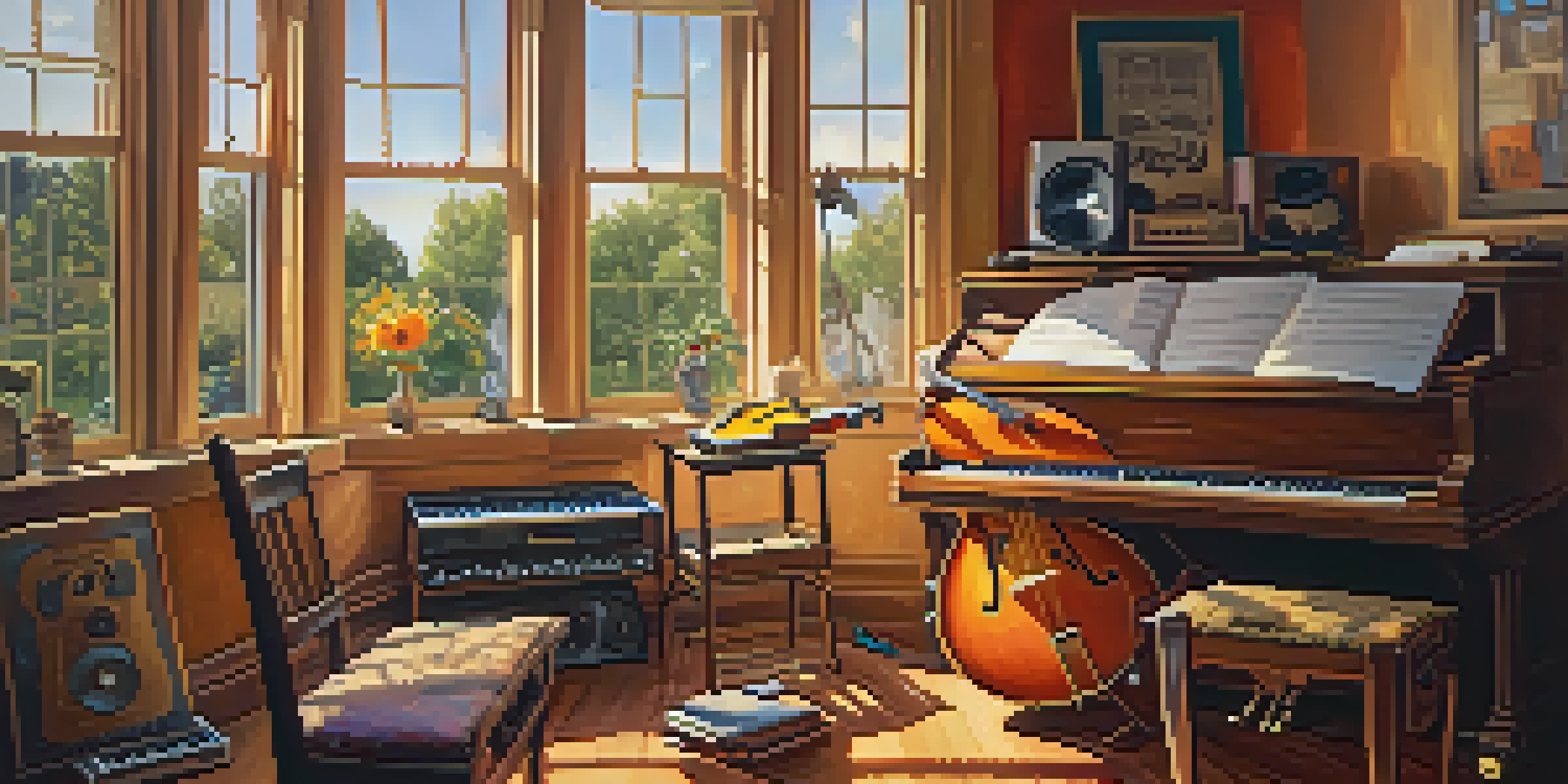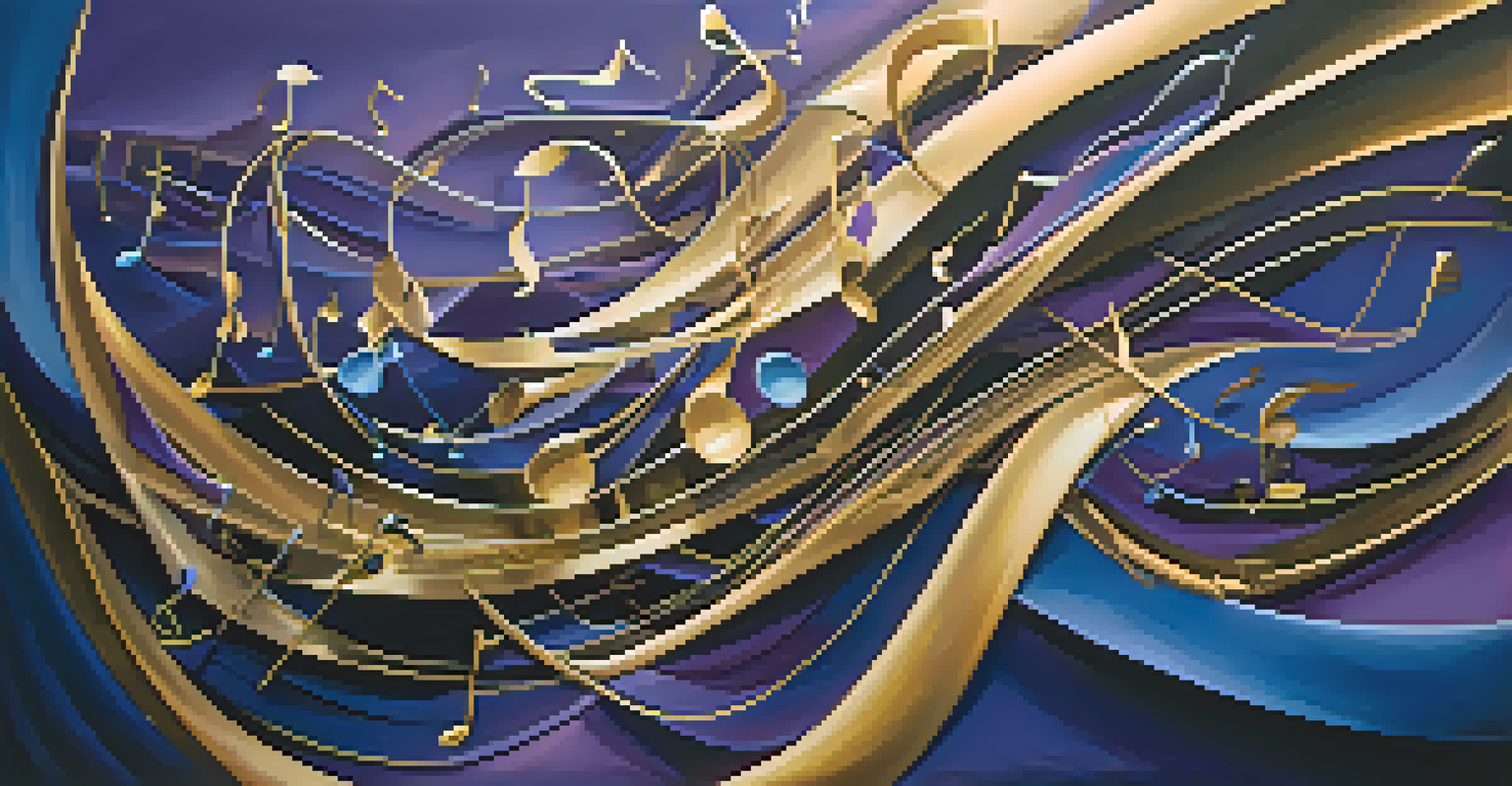Understanding Rhythm: Key Elements in Music Structure Study

What is Rhythm in Music and Why It Matters
Rhythm is the heartbeat of music—it's what makes you tap your feet or dance. Essentially, rhythm refers to the timing of notes and chords in music, dictating how they are organized in time. Without rhythm, music would feel chaotic and disorganized, making it hard for listeners to engage with it.
Rhythm is the pulse of music, and without it, everything falls apart.
Think of rhythm like the frame of a house; without it, the structure would collapse. Just as you need a solid foundation for a house, music requires a consistent rhythm to create a pleasing auditory experience. It provides a sense of movement and flow, guiding the listener through the piece.
In many genres, rhythm can even convey emotion, setting the mood for a song. Whether it's a fast-paced beat that energizes or a slow, steady rhythm that calms, understanding rhythm helps musicians connect with their audience on a deeper level.
The Basics: Beats and Measures Explained
At the core of rhythm are beats, the basic units of time in music. Beats are what you naturally count along to when listening to a song, often falling at regular intervals. Measures, or bars, group these beats together, creating a structure that helps musicians follow the flow of the music.

For instance, in a 4/4 time signature, there are four beats in each measure, creating a steady and familiar pattern. This is why many popular songs follow this structure, as it resonates well with listeners. On the other hand, time signatures like 3/4 or 6/8 introduce a different feel, often evoking a waltz-like rhythm.
Rhythm: The Heartbeat of Music
Rhythm organizes notes in time, creating structure and emotional depth in music.
Understanding beats and measures is crucial for both performers and composers. It allows them to create and interpret music effectively, ensuring that everyone is in sync, whether it's a solo artist or a full orchestra.
Tempo: The Speed of Music and Its Effects
Tempo refers to the speed at which music is played, typically measured in beats per minute (BPM). It can dramatically affect the mood and energy of a piece. A slow tempo might evoke feelings of sadness or reflection, while a fast tempo can energize and excite.
Music is the shorthand of emotion, and rhythm is its heartbeat.
Imagine walking at a leisurely pace versus sprinting down a track; the difference in tempo can create entirely different experiences. In music, this is why a ballad feels much different from a dance track, even if they share similar melodic elements.
Musicians often use tempo markings, such as 'Allegro' for fast or 'Adagio' for slow, to communicate the desired speed. Understanding how to manipulate tempo helps artists convey their intended emotions and engage their audience more effectively.
Rhythmic Patterns: The Building Blocks of Music
Rhythmic patterns are sequences of notes and rests arranged in time, forming the backbone of a musical piece. These patterns can range from simple to complex, creating a rich tapestry of sound. For example, a straightforward quarter note pattern can evolve into intricate syncopations that surprise and delight the listener.
Think of rhythmic patterns like a recipe; just as specific ingredients come together to create a dish, particular note combinations create the musical flavor. Composers often experiment with different patterns to find unique grooves that capture attention.
Understanding Beats and Measures
Beats and measures form the basic units of rhythm, crucial for musicians to maintain flow and sync.
Additionally, recognizing common rhythmic patterns can help musicians improvise and collaborate more effectively. When everyone understands the foundation of the rhythm, they can build on it together, resulting in a cohesive musical experience.
Syncopation: Adding Surprise and Interest
Syncopation involves placing emphasis on beats or parts of beats that are typically unaccented. This creates a sense of surprise and unpredictability in music, making it more engaging. For instance, when a musician plays a note slightly off the beat, it adds a unique twist that can captivate an audience.
Imagine a dancer who suddenly changes their rhythm; that unexpected move can grab everyone's attention. Similarly, syncopation can elevate a piece of music, making it more dynamic and memorable. It's a tool that many genres, from jazz to pop, use to keep listeners on their toes.
Understanding syncopation allows musicians to experiment with their sound, creating fresh and exciting compositions. By playing with the expected rhythm, they can evoke a range of emotions and keep their audience intrigued.
Polyrhythm: The Art of Layering Rhythms
Polyrhythm occurs when two or more contrasting rhythms are played simultaneously. This technique can create fascinating textures in music, as different rhythmic patterns interact and complement each other. For example, a drummer might play a steady beat on the hi-hat while using a different rhythm on the snare drum.
Think of polyrhythm like a conversation between friends; each person brings their unique perspective, creating a richer dialogue. In music, this layering can result in a complex and immersive listening experience that captures the audience's attention.
Exploring Syncopation and Polyrhythm
Syncopation adds surprise while polyrhythm layers contrasting rhythms, enriching the musical experience.
Many cultures around the world utilize polyrhythms, making it an essential element in genres like African drumming and jazz. Musicians who master this technique can add depth and sophistication to their compositions, inviting listeners to explore the intricate layers of sound.
Conclusion: The Importance of Rhythm in Music Study
In summary, understanding rhythm is crucial for anyone studying music, whether you're a performer, composer, or enthusiast. Rhythm provides the framework for musical expression, influencing how we perceive and enjoy music. By grasping its key elements—such as beats, tempo, patterns, syncopation, and polyrhythm—you can deepen your appreciation and understanding of the art form.
Moreover, rhythm serves as a universal language that transcends cultural boundaries, allowing people from different backgrounds to connect through music. As you dive deeper into your musical journey, remember that rhythm is the glue that holds everything together.

So, whether you're tapping your feet to a favorite song or experimenting with your own compositions, embrace the power of rhythm. It's not just a component of music; it's what makes the experience vibrant and alive.